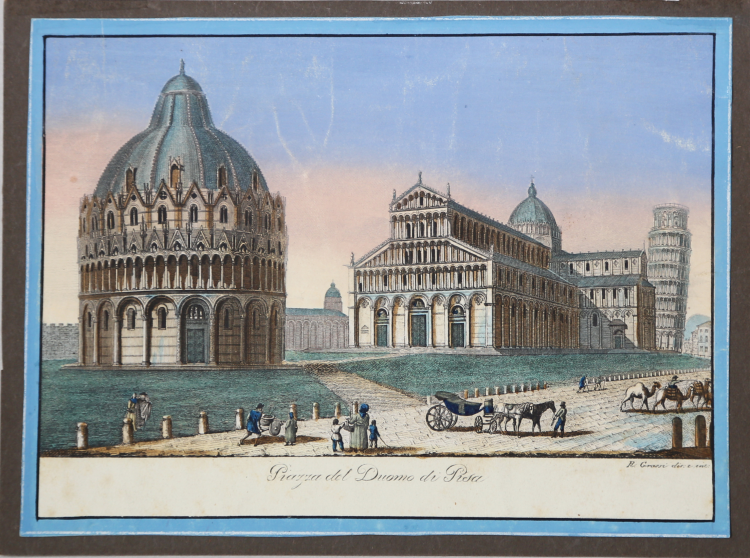


| Reference: | S220450 |
| Author | Ranieri GRASSI |
| Year: | 1834 |
| Zone: | Pisa |
| Printed: | Pise |
| Measures: | 210 x 160 mm |


| Reference: | S220450 |
| Author | Ranieri GRASSI |
| Year: | 1834 |
| Zone: | Pisa |
| Printed: | Pise |
| Measures: | 210 x 160 mm |
View of Piazza dei Miracoli taken from the famous collection of Ranieri Grassi Rappresentazione degli edifizi più cospicui di Pisa in XII tavole […], published by R. Prosperi in 1834 and 1839.
Copperplate, beautiful coeval coloring, in perfect condition.
|
Tosi L. (a cura di) "Pisa e il suo territorio: tra cartografia e vedutismo dal XV al XIX sec.", pag. 181, 265.
|
Ranieri GRASSI (attivo a Pisa nel XIX secolo)
|
Pisan engraver, drawer and erudite, Ranieri Grassi made his training at his father in lawCarlo Lasinio, printmaker and curator of the Campo Santo at Pisa. His production begins in the second decade of the nineteenth century engraving two views of the square of the Piazza del Duomo in Pisa, to go up to the Sixties and it is divided into various collections and numerous loose prints, all printed in Pisa by Ranieri Prosperi, aimed to represent "all the most beautiful and picturesque that Pisa has to be distinguished and magnificent among Italian cities." In 1829 Grassi published the first edition of Le fabbriche principali di Pisa ed alcune vedute della stessa città, illustrated by 16 plates, followed in 1831 by a second edition with 24 plates: the etchings, for which Grassi used the drawings of the artists Francesco Giuliani Florido and Galli, also were circulated loose and colorful (Tosi 2004, p. 21). The success prompted the author to replicate them in size small: 12 etchings making up Rappresentazione degli edifizj più cospicui di Pisa, that showed various editions from 1832 to 1860. Between 1836 and 1838 Grassi published Descrizione storica e artistica di Pisa e de' suoi contorni, copper plates XXII, in three volumes, with ample historical- artistic introduction, modeled on Pisa illustrata by Alessandro Morrona.
|
|
Tosi L. (a cura di) "Pisa e il suo territorio: tra cartografia e vedutismo dal XV al XIX sec.", pag. 181, 265.
|
Ranieri GRASSI (attivo a Pisa nel XIX secolo)
|
Pisan engraver, drawer and erudite, Ranieri Grassi made his training at his father in lawCarlo Lasinio, printmaker and curator of the Campo Santo at Pisa. His production begins in the second decade of the nineteenth century engraving two views of the square of the Piazza del Duomo in Pisa, to go up to the Sixties and it is divided into various collections and numerous loose prints, all printed in Pisa by Ranieri Prosperi, aimed to represent "all the most beautiful and picturesque that Pisa has to be distinguished and magnificent among Italian cities." In 1829 Grassi published the first edition of Le fabbriche principali di Pisa ed alcune vedute della stessa città, illustrated by 16 plates, followed in 1831 by a second edition with 24 plates: the etchings, for which Grassi used the drawings of the artists Francesco Giuliani Florido and Galli, also were circulated loose and colorful (Tosi 2004, p. 21). The success prompted the author to replicate them in size small: 12 etchings making up Rappresentazione degli edifizj più cospicui di Pisa, that showed various editions from 1832 to 1860. Between 1836 and 1838 Grassi published Descrizione storica e artistica di Pisa e de' suoi contorni, copper plates XXII, in three volumes, with ample historical- artistic introduction, modeled on Pisa illustrata by Alessandro Morrona.
|